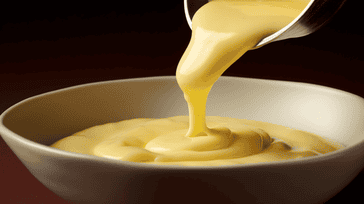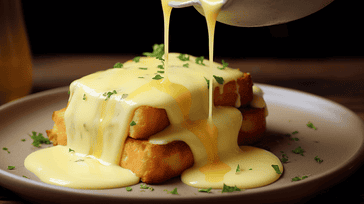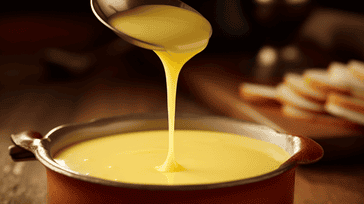
Velvety hollandaise sauce is one of the most indulgent condiments in the culinary world. With its smooth and creamy texture, this sauce elevates any dish to a whole new level. Whether you are drizzling it over eggs benedict or asparagus, velvety hollandaise sauce adds a touch of luxury to your meal.
One of the best things about hollandaise sauce is that it is easier to make than you might think. With a few simple ingredients and some basic cooking techniques, you can create your own velvety hollandaise sauce right at home. Plus, with the ability to customize the sauce with different herbs, spices, and other ingredients, you can make it truly your own.
In this article, we will explore everything you need to know about velvety hollandaise sauce. We will provide a step-by-step guide for making your own homemade sauce, as well as tips and tricks for perfecting the texture and flavor. Additionally, we will discuss different variations of hollandaise sauce and explore its pairings with various dishes. By the end of this article, you will be an expert in all things hollandaise sauce.
There's nothing quite like the rich, buttery flavor of homemade hollandaise sauce. While it may seem intimidating to make, it's actually quite simple with the right ingredients and techniques.
To make a basic hollandaise sauce, you'll need:
| Ingredients: | Amount: |
|---|---|
| Egg yolks | 3 |
| Unsalted butter, melted | 1/2 cup |
| Lemon juice | 1 tablespoon |
| Salt | 1/4 teaspoon |
| Cayenne pepper (optional) | A pinch |
Step-by-step guide:
Some people prefer to make hollandaise sauce over a double boiler, whisking the ingredients by hand. However, using a blender is a simpler and faster method that still produces excellent results.
Once you've mastered the basic recipe, you can add your own flair to hollandaise sauce. Try mixing in herbs like tarragon or chives, or spices like paprika or mustard powder. You can also swap out the lemon juice for vinegar or white wine.
When making hollandaise sauce, it's important to keep the heat low to prevent the eggs from scrambling. Make sure your melted butter is warm but not hot, and blend slowly to ensure the ingredients emulsify properly.
If your hollandaise sauce does start to curdle or thicken too quickly, try whisking in a bit of hot water or a fresh egg yolk to smooth it out.

Hollandaise sauce is a classic French sauce made by emulsifying butter and egg yolks. While the traditional recipe is delicious on its own, there are several variations that can elevate the flavor profile of this rich and creamy sauce.
Adding herbs to hollandaise sauce can bring a new dimension of flavor to the dish. Some popular herbs to add include tarragon, parsley, chives, and thyme. Simply chop the herbs finely and whisk them into the sauce after it has been emulsified.
| Herb | Flavor | Pairings |
|---|---|---|
| Tarragon | Anise-like and slightly sweet | Seafood, chicken, and vegetables |
| Parsley | Earthy and fresh | Steak, fish, and potatoes |
| Chives | Mild onion flavor | Potatoes, eggs, and salads |
| Thyme | Sweet and savory | Poultry, pork, and vegetables |
Spices can also be added to hollandaise sauce for a little extra kick. Some popular spices to add include cayenne pepper, paprika, and black pepper. Add the spices to the egg yolk mixture before emulsifying with the butter.
With these variations and tips, you can take your hollandaise sauce to the next level and impress your guests with your culinary skills.
Eggs benedict is not complete without a drizzle of hollandaise sauce. Here are some tips for achieving the perfect hollandaise sauce for your eggs benedict:
When making eggs benedict, the timing is crucial. The hollandaise sauce should be the last component made before assembling the dish. This ensures the sauce is served warm and at the correct consistency. It also prevents the sauce from overheating and curdling due to sitting too long.
When making hollandaise sauce for eggs benedict, it is recommended to use a whisk instead of a blender. A blender can easily over-process the sauce, leading to a thinner consistency and a loss of flavor. Using a whisk allows for better control and a creamier texture.
When making hollandaise sauce, the temperature of the butter is crucial. If the butter is too hot, it can separate the egg yolks and create a greasy sauce. If the butter is too cold, it may not properly emulsify with the egg yolks. The ideal butter temperature is around 120°F.
For eggs benedict, the hollandaise sauce should have a thicker consistency than a standard hollandaise sauce. This helps the sauce cling to the poached eggs and English muffin. If the sauce is too thin, it will run off the dish and not provide the desired flavor and texture.
Follow these tips for a perfect hollandaise sauce for your eggs benedict. Happy cooking!

There's something undeniably luxurious about velvety hollandaise sauce, with its creamy texture and rich, buttery flavor. It's the perfect accompaniment to eggs benedict or as a topping for vegetables like asparagus or broccoli.
What makes hollandaise sauce so special is the technique used to make it. By slowly whisking together egg yolks, lemon juice, and melted butter, hollandaise sauce achieves its signature creamy texture. It's a delicate balance of ingredients and a skilled hand that creates the perfect sauce.
To truly savor the creamy goodness of velvety hollandaise sauce, it's important to use high-quality ingredients. Choose fresh, organic eggs and butter for the best results.
Whether you're a fan of classic eggs benedict or looking for a new way to add flavor to your favorite dishes, velvety hollandaise sauce is a culinary delight worth exploring.
Hollandaise sauce is a delicious and creamy addition to any meal, but it can also be a bit tricky to perfect. Here are some commonly asked questions about hollandaise sauce to help you on your culinary journey.
Leftover hollandaise sauce can be stored in an airtight container in the refrigerator for up to 2 days. When reheating, use a double boiler or a heatproof bowl set over a pot of simmering water to gently warm the sauce, stirring occasionally. Avoid reheating in the microwave, as this can cause the sauce to separate or curdle.
If your hollandaise sauce is too thin, it may be because you didn't whisk it enough during the cooking process. Try whisking the sauce over low heat for an additional minute or two. If the sauce is too thick, you can whisk in a small amount of warm water or lemon juice to thin it out to your desired consistency.
While it is possible to make hollandaise sauce ahead of time and reheat it later, it is best served fresh. If you must make it ahead of time, store it in an airtight container in the refrigerator and reheat as described above.
It is not recommended to freeze hollandaise sauce, as it may separate or become grainy when thawed.
While it is possible to use a blender to make hollandaise sauce, it can be more difficult to achieve the right consistency. If using a blender, be sure to use a low speed and blend in short bursts to avoid over-whipping the sauce.
Hollandaise sauce is a versatile condiment that can be served with a variety of dishes, including eggs benedict, vegetables, and seafood. It is best served warm and freshly made.

Velvety hollandaise sauce is a versatile ingredient that can go beyond the traditional pairing with eggs benedict. Here are some delicious dishes and ingredients that pair well with hollandaise sauce:
| Dish/Ingredient | Description/Preparation |
|---|---|
| Asparagus | Boil or steam asparagus until tender and drizzle hollandaise sauce over the top for a classic side dish. |
| Salmon | Grill or bake salmon and serve with hollandaise sauce for an indulgent seafood meal. |
| Artichokes | Steam artichokes until tender and serve with hollandaise sauce as a delicious dip. |
| Steak | Top a grilled or pan-seared steak with hollandaise sauce for a decadent surf-and-turf dish. |
| Crab cakes | Enjoy crispy and flavorful crab cakes with the added richness of hollandaise sauce on top. |
If you want to get more creative, try experimenting with different herbs or spices in your hollandaise sauce. Tarragon, dill, and cayenne pepper are just some examples of flavorings that can add depth and complexity to your dish.
Hollandaise sauce is a staple in French cuisine, and perfecting it requires time, patience, and skill. Here are some expert tips to help you achieve a creamy and smooth hollandaise sauce every time.
The key to a delicious hollandaise sauce is using fresh, high-quality ingredients. This includes fresh egg yolks, freshly squeezed lemon juice, and unsalted butter. Using old or low-quality ingredients can affect the flavor and texture of the sauce.
Hollandaise sauce is notoriously difficult to make because it can easily break or curdle. To prevent this, use a double boiler to gently heat the sauce. This method involves placing a heatproof bowl over a pot of simmering water, which helps to regulate the temperature and prevent overheating.
A key part of making hollandaise sauce is whisking the egg yolks vigorously until they become thick and creamy. This requires a lot of effort and can take up to 5-10 minutes, but it's worth it to achieve the perfect texture. Use a wire whisk and make sure to whisk continuously, taking care not to overwhisk the mixture.
When adding the melted butter to the egg yolks, do so very slowly, whisking continuously to prevent the sauce from breaking. This process should take several minutes, and it's important to be patient and take your time. Don't rush the process or you risk ruining the sauce.
Once you've made your hollandaise sauce, taste it and adjust the seasoning as needed. Add a pinch of salt or a squeeze of lemon juice to balance the flavors and enhance the sauce's richness. Remember, hollandaise sauce should be creamy, buttery, and tangy, so don't be afraid to experiment until you find the perfect balance.
There's no denying that eggs benedict has become synonymous with hollandaise sauce. The combination of a perfectly poached egg, crispy bacon, and soft, toasted English muffin topped with a decadent drizzle of velvety hollandaise sauce is a breakfast lover's dream come true!
But why stop there? Hollandaise sauce can elevate so many other breakfast classics. For instance, it can be used to replace ketchup on your breakfast sandwich, or as a topping for your breakfast burrito. It can also be added to your scrambles and omelets for a delicious and creamy twist.
The rich and buttery taste of hollandaise sauce perfectly complements a wide range of breakfast ingredients, such as smoked salmon, sautéed mushrooms, and grilled asparagus. It's also a fantastic dip for hash browns or crispy tater tots.
Get creative with your hollandaise sauce pairings and find new ways to enjoy its creamy goodness at breakfast time!
As a culinary favorite, hollandaise sauce can be a tricky recipe to master. Here are a few more frequently asked questions about making the perfect, creamy hollandaise sauce:
Yes, hollandaise sauce can be refrigerated for up to 3 days. However, it may separate and become difficult to reheat. To reduce the risk of separation, store it in an airtight container and reheat it gently over a double boiler while whisking constantly.
If your hollandaise sauce is too thick, you can thin it out by whisking in a little bit of hot water or lemon juice until it reaches your desired consistency.
Hollandaise sauce can separate if it gets too hot or if it is over-whisked. To prevent separation, keep the heat low and avoid over-whisking. If your hollandaise sauce does separate, try whisking in a little lukewarm water or egg yolk to bring it back together.
It is not recommended to freeze hollandaise sauce, as it can separate and lose its flavor and texture when thawed.
Hollandaise sauce can be flavored with a variety of herbs, spices, and other ingredients. Try whisking in some finely chopped tarragon, chives, or garlic for a unique flavor twist. Citrus zest or hot sauce can also add a pop of flavor.
Hollandaise sauce is often used in classic dishes like eggs benedict, asparagus with hollandaise, and grilled salmon. It can also be served with poached eggs, roasted vegetables, or grilled meats.
By keeping these tips and tricks in mind, you'll be well on your way to mastering the art of hollandaise sauce!